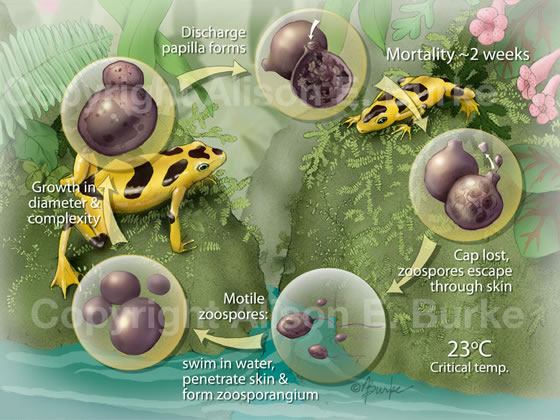Research Overview
For a long time, Chytrid
fungi were thought to be free-living saprophytes with only
few species capable of infecting plants and invertebrates.
However, a new species with deadly characteristics surfaced
in 1999, Batrachochytrium dendrobatidis (Bd) that
could infect the skin cells of many amphibians, causing the
often fatal chytridiomycosis. Many scientists now link the
spread of Bd to the rapidly declining amphibian populations
(For more on the amphibian decline debate, read Collins
and Storfer 2003). The mass extinction of amphibians
threaten the sustainablity of many ecosystems that depend
on the roles of these animals.
Bd most lkely originated
in South Africa and spread through water and amphibian-to-amphibian
contact (For more on the history of Bd, read Weldon
et al. 2004; Ouellet
et al. 2003). Bd thrives in moist cool habitats and its
possible transmission through water makes its infectious
rates exponential. Not all amphibian species are at risk.
For example, American Bull Frogs show resistance to the fungi.
While the presence of resistance species might seem extremely
beneficial, resistant species may actually pose a greater
threat due to their role as Bd carriers, transmitting the
fungi to new areas and infecting other susceptible species
(For more on resistance, read Woodhams
et al. 2007).
While the spread of Bd
has been thoroughly studied in areas such as Central America,
its affect in other climates like North America is unclear.
The varied climates of North America may keep Bd from spreading
in certain regions but no studies have been done in our area.
(For more on climate, read Kiger
and Hero 2006). In addition, in the Piedmont region of
North Carolina, little is known about whether
Bd poses danger to local amphibains.
In collaboration with Dr. Michael E. Dorcas (Davidson College)
and his herpetology lab, we hope to develop and refine a
procedure to detect amphibain DNA from field samples, as
well as, quantify the infection of those identified to have
Bd spores on their skin.
Chytrid Life Cycle (Top) and the Global Spread of Chytrid (Bottom)


Photo
credits can be found on acknowlegements page
This site was designed and created by G. Bomar as part of a summer undergraduate
research program at Davidson College.
|